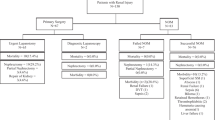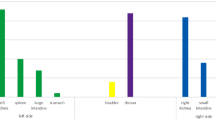Abstract
Background
Nonoperative management (NOM) of kidney gunshot injuries as an alternative to surgical exploration is rarely reported. The aim of this study was to assess the feasibility and safety of selective NOM of such injuries.
Methods
A 4-year prospective study was conducted that included all patients admitted to a Level I trauma center with kidney gunshot injuries. Patients with abdominal gunshot wounds and hematuria with no indications for immediate laparotomy (peritonitis, hemodynamic instability, head or spinal cord injury) underwent intravenous contrast abdominal computed tomography. Patients with confirmed kidney injuries were observed with serial clinical examinations. Outcome parameters included the need for delayed laparotomy, complications, length of hospital stay, and survival.
Results
During the study period, 33 patients with kidney gunshot injuries were selected for NOM without laparotomy. The mean Injury Severity Score was 10.5 (range 4–25). Simple kidney injuries (grades I, II) occurred in 15 (45.5%) patients and complex kidney injuries (grades III, IV) in 18 (54.5%) patients. Associated injuries included 14 of the liver (42.4%), 4 (12.1%) of the spleen, and 6 (18.2%) each of the diaphragm, lung (contusion), and hemothorax. Three patients required delayed laparotomy: two for nonrenal indications, and one patient had a delayed nephrectomy for a grade IV injury. The overall successful NOM rate was 90.9%. The mean hospital stay was 5.9 days (range 2–23 days). There were no kidney-related complications and no mortality.
Conclusion
Selective NOM of patients with kidney gunshot injuries is a feasible, safe, effective alternative to routine exploration.

Similar content being viewed by others
References
Navsaria PH, Ju Berli, Edu S et al (2007) Non-operative management of abdominal stab wounds: an analysis of 186 patients. S Afr J Surg 45:128–132
Demetriades D, Charalambides D, Lakhoo M et al (1991) Gunshot wound of the abdomen: role of selective conservative management. Br J Surg 78:220–222
Velmahos GC, Demetriades D, Foianini E et al (1997) A selective approach to the management of gunshot wounds to the back. Am J Surg 174:342–346
Velmahos GC, Demetriades D, Toutouzas KG et al (2001) Selective nonoperative management in 1,856 patients with abdominal gunshot wounds: should routine laparotomy still be the standard of care? Ann Surg 234:395–402
Demetriades D, Velmahos G, Cornwell E III et al (1997) Selective nonoperative management of gunshot wounds of the anterior abdomen. Arch Surg 132:178–183
Pryor JP, Reilly PM, Dabrowski GP et al (2004) NOM of abdominal gunshot wounds. Ann Emerg Med 43:344–353
Thall EH, Stone NN, Cheng DL et al (1996) Conservative management of penetration and blunt type III renal injuries. J Urol 77:512–517
Wessels H, McAninch JW, Meyer A et al (1997) Criteria for nonoperative treatment of significant penetrating renal lacerations. J Urol 157:24–27
Armenakas NA, Duckett CP, McAninch JW (1999) Indications for nonoperative management of renal stab wounds. J Urol 161:768–771
Davis KA, Reed RL 2nd, Santaniello J et al (2006) Predictors of the need for nephrectomy after renal trauma. J Trauma 60:164–169
Kansas BT (2004) Incidence and management of penetrating renal trauma in patients with multiorgan injury. J Urol 172:1355–1360
Shariat SF, Roehrborn CG, Karakiewicz PI et al (2007) Evidence-based validation of the predictive value of the American Association for the Surgery of Trauma Kidney Injury Scale. J Trauma 62:933–939
Heyns CF (2004) Renal trauma: indications for imaging and renal exploration. BJU Int 93:1165–1170
McAninch JW, Carroll PR, Armenakas NA et al (1993) Renal gunshot wounds: methods of salvage and reconstruction. J Trauma 35:279–283
Velmahos GC, Demetriades D, Cornwell EE et al (1998) Selective management of renal gunshot wounds. Br J Surg 85:1121–1124
Renz BM, Bott J, Feliciano DV (1996) Failure of nonoperative treatment of a gunshot wound to the liver predicted by computed tomography. J Trauma 40:191–193
Philips T, Scalafini SJ, Goldstein A et al (1986) Use of contrast-enhanced CT enema in the management of penetrating trauma of the flank and back. J Trauma 26:593–601
Sherck J, Shatney C, Sensaki K et al (1994) The accuracy of computed tomography in the diagnosis of blunt small bowel perforation. Am J Surg 168:670–675
Cheng DLW, Lazan D, Stone N (1994) Conservative treatment of type III renal trauma. J Trauma 36:491–494
Hammer CC, Santucci RA (2003) Effect of an institutional policy of nonoperative treatment of significant penetrating renal lacerations. J Urol 169:1751–1753
DuBose J, Inaba K, Teixeira PG et al (2007) Selective non-operative management of solid organ injury following abdominal gunshot wounds. Injury 38:1084–1090
Author information
Authors and Affiliations
Corresponding author
Rights and permissions
About this article
Cite this article
Navsaria, P.H., Nicol, A.J. Selective Nonoperative Management of Kidney Gunshot Injuries. World J Surg 33, 553–557 (2009). https://doi.org/10.1007/s00268-008-9888-y
Published:
Issue Date:
DOI: https://doi.org/10.1007/s00268-008-9888-y




